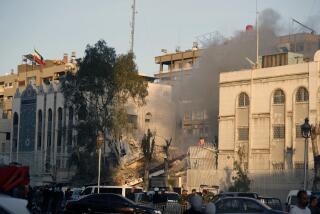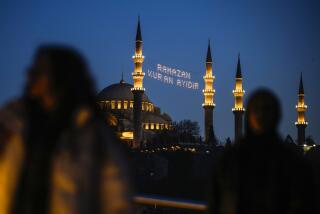New images of Islamic State destruction at Palmyra show extent of ‘atrocity-class event’
Reports began to trickle into the Western media Sunday that Islamic State militants in Syria had done the unthinkable: used explosives to level a 2,000-year-old temple at the UNESCO World Heritage Site of Palmyra. The Temple of Baalshamin, which dates back to AD 17 and was expanded under the reign of the Roman emperor Hadrian, had been reduced to rubble.
Photos that have begun appearing on a social media website frequented by radicals now show the extent of the damage: plumes of smoke over the former sacred pagan site, and mounds of detritus where a temple once stood.
Irina Bokova, the director of UNESCO, labeled the action a “war crime.”
“The art and architecture of Palmyra, standing at the crossroads of several civilizations, is a symbol of the complexity and wealth of the Syrian identity and history,” she wrote in a statement released Monday. “Extremists seek to destroy this diversity and richness, and I call on the international community to stand united against this persistent cultural cleansing.”
Whether that will happen seems unlikely. Militants have occupied the area since May, and in that time, they have organized mass killings of Syrian soldiers, government leaders and civilians. Last week, they beheaded Khaled Asaad, a prominent Syrian archaeologist who was a key scholar of the site -- a murder that raised outrage in cultural circles.
This is likely just a taste of what is to come. As Times correspondents Laura King and Nabih Bulos reported on Monday, Islamic State militants are systematically looting artifacts to reportedly sell on the black market -- a way of funding their operations. Moreover, the spectacular damage to some ancient sites can serve as an important recruiting tool.
“You can’t sell a building like the temple, big huge statues, so [you] might as well benefit from them in other ways,” Amr Al-Azm, an associate professor of Middle East history at Shawnee State University in Ohio told The Times. “It’s all about exploiting a resource here. What you cannot sell, you destroy for propaganda through what I call ‘atrocity-class’ events, usually associated with very glossy, fancy videos and with people speaking and explaining the act itself.”
Certainly, dramatic images of black clouds of destruction hovering over important ancient sites can serve such a purpose.
Moreover, the city itself serves as a symbol of multicultural, multi-religious tolerance.
“Palmyra is not just a spectacular archaeological site, beautifully preserved, excavated and curated,” Tim Whitmarsh, a professor of Greek history, writes in the Guardian. “It also offers antiquity’s best counterexample to [the Islamic State’s] fascistic monoculturalism. The ancient city’s prosperity arose thanks to its citizens’ ability to trade with everyone, to integrate new populations, to take on broad diverse cultural influences, to worship many gods without conflict. Painful though it is to say it, and unlikely though it is that its asinine followers realise it, [Islamic State militants] have chosen their target exceptionally well.”
There are still many other ruins standing at Palmyra: dramatic colonnades, graceful temples and a Roman amphitheater. For 2,000 years, they have survived changes in empire and the ravages of time. But they may not survive a group hellbent on stripping a region down to a single insular and xenophobic way of thinking.
Find me on Twitter @cmonstah
More to Read
The biggest entertainment stories
Get our big stories about Hollywood, film, television, music, arts, culture and more right in your inbox as soon as they publish.
You may occasionally receive promotional content from the Los Angeles Times.







